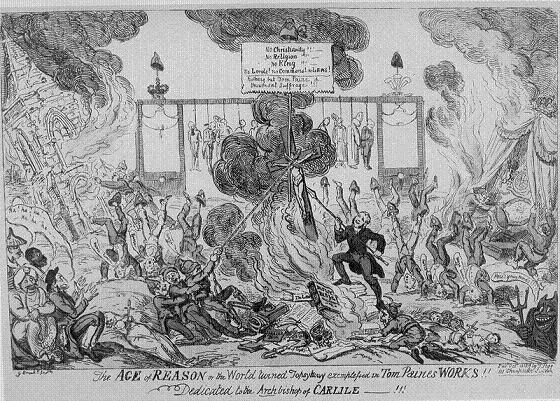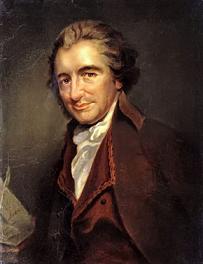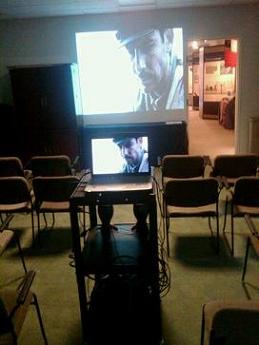Rapture-ready
In honor of us all ‘surviving’ this weekend’s apocalypse, here’s a brief bio on Morgan Edwards, a colonial-era historian and pastor, most notable for preaching the 'Rapture.'
According to its theological definition the Rapture is: “a reference to the Biblical passage when in the ‘End Times’ the Christians of the world will be gathered together to meet their Savior Jesus Christ. The primary passage used to support the idea of the Rapture is 1 Thessalonians 4:15–7, in which the apostle Paul cites ‘the word of the Lord’ about the return of Christ to gather his saints....and the dead in Christ shall rise first: Then we which are alive and remain shall be caught up together with them in the clouds, to meet the Lord in the air: and so shall we ever be with the Lord.”
Morgan Edwards is said to have been one of the first ministers to preach on the concept of the Rapture long before it was embraced by portions of the evangelical church. Born in Wales, Edwards attended and graduated from Bristol College before assuming the life of a full-time preacher in 1738. After pastoring churches in England for seven years, he moved to Ireland and led worship there for almost a decade before immigrating to the American Colonies. Upon his arrival in 1761, Edwards was appointed as the pastor of the Baptist Church in Philadelphia. While there he became the only clergyman from that denomination to side with the Tories during the Revolutionary War. ‘Toryism’ was a traditionalist and conservative political philosophy that was often embraced by those who remained loyal to the British Crown. In many cases Tories or Loyalists of any kind were branded as traitors and publicly humiliated or ridiculed. Edward’s position as a man of the cloth no doubt protected him from retribution.
Edwards left the pulpit in 1771 and became one of the most respected Christian historians of the day. Some Baptist scholars credit him as being the first of his denomination to record and publish chronicles of the church. In 1770 he finished his first major work titled Materials Toward A History of the Baptists in Pennsylvania presenting the origins of the Baptist Church in America and in 1792 he added a companion volume titled Materials Toward A History of the Baptists in New Jersey. He also wrote 42 volumes of sermons (12 per volume) that were never printed.
In 1764 Edwards joined a group of influential public figures (including the Reverends Manning, Stiles, Backus, Gano, Stillman, Ellery, as well as former Royal Governors Hopkins and Ward) in order to charter the College in the English Colony of Rhode Island and Providence Plantations which would later become known as Brown University. As an Ivy League school, Brown was the first Baptist College in the original thirteen colonies. Edwards died in Delaware in 1795 (Read funeral sermon) and was buried back near his church in Philadelphia. Most notable in Edward’s legacy as a minister was his progressive-teachings of the concept of “pretribulationism,” in which believers would be translated into Heaven prior to the events of the Tribulation as recorded in the Book of Revelations. In 1788 Edwards wrote that:
The distance between the first and second resurrection will be somewhat more than a thousand years. I say, somewhat more—, because the dead saints will be raised, and the living changed at Christ’s “appearing in the air” (I Thes. iv. 17); and this will be about three years and a half before the millennium, as we shall see hereafter: but will he and they abide in the air all that time? No: they will ascend to paradise, or to some one of those many “mansions in the father’s house” (John xiv. 2), and disappear during the foresaid period of time. The design of this retreat and disappearing will be to judge the risen and changed saints; for “now the time is come that judgment must begin,” and that will be “at the house of God” (I Pet. iv. 17).
Perhaps time will tell if Morgan Edwards was right. We now know that this past Saturday's anticipated "Judgment Day" (5/21/2011) failed to live up to many believers expectations. Perhaps they should have opened their bibles to Matthew 24:36 where it says that: “No one knows about that day or hour, not even the angels in heaven, nor the Son, but only the Father."
The beliefs of an unbeliever

George Cruikshank cartoon attacking Thomas Paine. The caption reads:
“The Age of Reason; or, the World turned Topsy-turvy exemplified in Tom Paine’s Works!”
Often referred to as the “Father of the American Revolution,” Thomas Paine was also THE best-selling author in eighteenth-century America. Even those with a casual knowledge of our nation’s history are familiar with his most popular work titled Common Sense. This of course was the radical political-pamphlet that he anonymously published (as “an Englishman”) in January of 1776. Common Sense presented the American colonists with an argument for freedom from English rule at a time when the question of independence was still being debated. Upon its release, Common Sense quickly spread among the literate and within three months, 100,000 copies were sold throughout the colonies.
Many people forget that Thomas Paine went on to write a highly controversial deistic-pamphlet titled The Age of Reason; Being an Investigation of True and Fabulous Theology. This publication levied harsh criticism on the institution of organized religion and challenged the very legitimacy of the Christian Bible. Published in three parts over a period of three years (1794, 1795, and 1807), it was also a best-seller that ignited a short-lived deistic revival.
Much like Thomas Jefferson who wrote his own interpretation of scripture, Paine favored scientific-reason over faith and rejected all biblical references to miracles. While promoting the concept of “natural religion” he openly abandoned the notion that the Christian Bible was a divinely inspired book and argued against the very existence of a creator-God. By taking a philosophical stance that was usually reserved for the educated-elite and making it irreverent (and inexpensive), Paine was able to appeal to a mass readership, thus increasing sales while spreading his divisive message. Although (at the time) it did not sell nearly as well as Common Sense, The Age of Reason went through seventeen editions and sold thousands of copies in the United States.
Not surprising, Paine’s irreverent assumptions on organized religion (Christianity in particular) were met with much anger and outrage, especially from the Church of England. The British government reacted to this by prosecuting any printer or bookseller that tried to produce and/or distribute the book. The content of The Age of Reason was divided into three sections: In Part I, Paine outlined his major arguments and personal creed. In Parts II and III, he analyzed specific portions of the Christian Bible in order to demonstrate that it was not the revealed “Word of God.” Throughout the book Paine placed an emphasis on the individual’s right of conscience and an inherent accountability to be held to oneself. At the beginning of Part I, Paine summarized his personal creed:
I believe in one God, and no more; and I hope for happiness beyond this life.
I believe in the equality of man; and I believe that religious duties consist in doing justice, loving mercy, and endeavoring to make our fellow-creatures happy.
But, lest it should be supposed that I believe many other things in addition to these, I shall, in the progress of this work, declare the things I do not believe, and my reasons for not believing them.
I do not believe in the creed professed by the Jewish Church, by the Roman Church, by the Greek Church, by the Turkish Church, by the Protestant Church, nor by any church that I know of. My own mind is my own church.
All national institutions of churches, whether Jewish, Christian or Turkish, appear to me no other than human inventions, set up to terrify and enslave mankind, and monopolize power and profit.
I do not mean by this declaration to condemn those who believe otherwise; they have the same right to their belief as I have to mine. But it is necessary to the happiness of man that he be mentally faithful to himself. Infidelity does not consist in believing, or in disbelieving; it consists in professing to believe what he does not believe.
In his argument against the Bible, Paine not only questioned the sacredness of the text, but also its historical origins. He often referred to the stories as “fabulous mythology” and stated that the Book of Proverbs was “inferior in keenness to the proverbs of the Spaniards, and not more wise and economical than those of the American Franklin [referring to Benjamin].” Paine then went on to question the overall consistency and accuracy of the Bible, blaming the errors on man as opposed to a divine being. Many of his comparative-reasoning styles are still practiced today in biblical scholarship.
The Old Testament in particular became a major target for Paine’s criticisms. He argued that the God of the Old Testament was so tyrannical and cruel that he could only be a “human-authored-myth.” He then went on to present a series of incidents supporting this theory including an account from the Book of Numbers, specifically 31:13–47, in which Moses orders the slaughter of thousands of boys and women, as well as the abduction of virgins. Excerpt: “15 ‘Have you allowed all the women to live?’ he asked them. 16 ‘They were the ones who followed Balaam’s advice and enticed the Israelites to be unfaithful to the LORD in the Peor incident, so that a plague struck the LORD’s people. 17 Now kill all the boys. And kill every woman who has slept with a man, 18 but save for yourselves every girl who has never slept with a man.’” Paine called this kind of content a “book of lies, wickedness, and blasphemy; for what can be greater blasphemy than to ascribe the wickedness of man to the orders of the Almighty!”
 Another sentiment offered up by Paine was the distrust of religious institutions. This included the indicting of priests for their want of power and the Church’s opposition to scientific investigation. He recalled: “Soon after I had published the pamphlet ‘Common Sense,’ in America, I saw the exceeding probability that a revolution in the system of government would be followed by a revolution in the system of religion. The adulterous connection of Church and State, wherever it has taken place has so effectually prohibited by pains and penalties every discussion upon established creeds, and upon first principles of religion, that until the system of government should be changed, those subjects could not be brought fairly and openly before the world; but that whenever this should be done, a revolution in the system of religion would follow.”
Another sentiment offered up by Paine was the distrust of religious institutions. This included the indicting of priests for their want of power and the Church’s opposition to scientific investigation. He recalled: “Soon after I had published the pamphlet ‘Common Sense,’ in America, I saw the exceeding probability that a revolution in the system of government would be followed by a revolution in the system of religion. The adulterous connection of Church and State, wherever it has taken place has so effectually prohibited by pains and penalties every discussion upon established creeds, and upon first principles of religion, that until the system of government should be changed, those subjects could not be brought fairly and openly before the world; but that whenever this should be done, a revolution in the system of religion would follow.”
Over the years many historians have supported to notion that Paine’s religious and political philosophies were very much in support of one-another. Therefore Paine felt that propagating a religious revolution was crucial to the success of any political revolution, not only because the Church controlled the State, but also because it required a radically new way of thinking and looking at the world. The threat to achieving this “political enlightenment” was directly attributed to a religious superstition that prevented oneself from diversifying their antiquated perspective or rejecting what they had been taught. Scholars have referred to this theory as Paine’s “secular-millennialism.” Perhaps Paine’s most telling statement on the subject of reform (religious and otherwise) came in the conclusion to his Rights of Man when he stated: “From what we now see, nothing of reform in the political world ought to be held improbable. It is an age of revolutions, in which everything may be looked for.”
Thomas Paine’s thoughts on this world (and the next) are still debated today. In 2006, English writer and Atheist Christopher Hitchens wrote a book about the affect of Paine’s writings. In it he summarized the need for his words in today’s political spectrum. He wrote, “If the rights of man are to be upheld in a dark time, we shall require an age of reason. In a time when both rights and reason are under several kinds of open and covert attack, the life and writing of Thomas Paine will always be part of the arsenal on which we shall need to depend.” Read The Age of Reason; Being an Investigation of True and Fabulous Theology.
The Repercussions of Revisionist History

Most people are familiar with the “The Patriot” starring Mel Gibson, Jason Isaacs and Heath Ledger. Released in 2000, this film depicts the story of a South Carolinian family swept up in the American Revolutionary War. The protagonist, Benjamin Martin, was loosely based on Francis Marion (the Swamp Fox) and the movie’s villain, Colonel William Tavington, was based on the British cavalryman Banastre Tarleton. Despite being nominated for three Academy-Awards, “The Patriot” received mixed reviews. There were some historical inaccuracies (like the church burning scene) tossed in for dramatic effect, but overall the film did an excellent job of depicting the trials suffered by both citizen and soldier.
Another Revolutionary War film that very few people know of is “The Spirit of ’76.” Produced in 1917, this silent movie has been lost for generations. Although no existing prints of this film have survived, the history of “The Spirit of ’76” resurfaced in 2000 due to the popularity of “The Patriot.” Originally this film was censored by the U.S. Government, because the United States had just declared war on Germany and England was an ally. After scenes of British atrocities had been ordered cut from the movie, the film’s primary writer/producer (Robert Goldstein) snuck them back in. As a result, Goldstein found himself prosecuted under President Woodrow Wilson's Wartime Espionage Act and sentenced to ten years in prison.
The sentence was later commuted to three years, but Goldstein was financially wiped out and spent the remainder of his life unsuccessfully demanding restitution. He sent many letters to the Academy of Motion Pictures complaining of his ill treatment and asking for help in reclaiming his career. In one letter he wrote, “I am merely a lone man suffering a great wrong for no reason whatever, can you refuse to help me obtain justice? I have never done the slightest thing to warrant this persecution and prejudice against me, which denies the very right to exist. What, in the name of common sense, can be the reason for such wanton injustice?”
According to the “The Spirit of ’76's” wiki-page: The film was produced by Robert Goldstein (born September 21, 1883) who was a Jewish immigrant originating from Germany and owned a costume shop. It was considered controversial at the time because of its depiction of the British atrocities during the American Revolutionary War, such as the Wyoming Massacre, which did not fit well with the vast British Empire being now supported by America in a war against the original supporters of American independence which was furthermore squarely against American interest. The film depicted scenes in which British soldiers committed not just stock character atrocities—such as killing babies and dragging young women out to a "terrible fate"—but also pure fiction: the film purportedly not only showed King George III hitting Benjamin Franklin squarely in the face and also having Catherine Montour as a mistress. A court case followed in which the prosecution argued that the World War I effort demanded total Allied support. The film was seized by the U.S. Government and Goldstein was sentenced to ten years in jail (later commuted to three years by President Wilson) for making the film.
For more details, read Timothy Noah’s Slate article on Robert Goldstein titled The Unluckiest Man in Movie History or read Robert Goldstein’s book: Robert Goldstein and "The Spirit of '76" (Edited by Anthony Slide).
Manassas Museum screening
 This past weekend’s screenings of "The Angel of Marye’s Heights" at Manassas Museum went very well. I want to thank store manager Jane Riley for her invitation, as well as Greg Clemmer for his excellent article that ran in the Washington Examiner.
This past weekend’s screenings of "The Angel of Marye’s Heights" at Manassas Museum went very well. I want to thank store manager Jane Riley for her invitation, as well as Greg Clemmer for his excellent article that ran in the Washington Examiner.
We had a near-capacity crowd at both showings and the audience really enjoyed themselves. The Gift Shop almost ran out of our DVDs and several folks inquired about booking shows for their organizations. This was my third time appearing at the MM. My previous speaking engagements were in support of my books. We were set-up in the museum’s conference room. The smaller space provided a more intimate setting than some of our larger screenings and facilitated a more personal discussion. The first showing resulted in a 15-minute Q&A session covering the Battle of Fredericksburg and documentary filmmaking.
Prior to the film I discussed the uniqueness of the Kirkland story (and statue) in relationship to the Fredericksburg Battlefield. I reminded the audience that although most Civil War battlefields (such as Gettysburg, Antietam and Manassas) feature towering equestrian monuments depicting the generals, the only depiction at the Fredericksburg Battlefield is that of a lone infantry sergeant and a fallen foe. This I explained is because they wanted to preserve not only the memory of Richard Kirkland in my opinion, but also the courage and sacrifice of the common soldier. I then challenged all of us to use the 150th Anniversary of the Civil War as an opportunity to preserve and present not just the stories of these “marquee commanders,” but also the experiences of the common soldier, citizen and slave. I added that this is exactly why I enjoy the museum at Manassas so much, as they have made a concerted effort to develop exhibits that deal with the wartime lives of everyday people.
During the second showing I discussed how we as filmmakers strived to depict the futility of war and the senselessness of the assault at Marye’s Heights. This challenge was accomplished through a series of animations in which we ‘hover’ the viewer over an animated 2D map (literally) and then immerse them down into a 3D animated battlefield terrain. I closed the talk by offering up my own astonishment at the courage and tenacity of the Federal troops who made that doomed assault again and again and again. I stated that if there was ever an example of fulfilling one’s duty that was it.
My next event will be at the Gathering of Eagles on June 4th. This will be my fourth appearance at what is truly a remarkable weekend of historical re-enactments, discussions and debates. I will be set-up in the author’s area selling copies of our DVD, as well as the title soundtrack on CD. I will have information on my books as well although I won’t have any copies available for purchase. I hope to see you there!







 Another sentiment offered up by Paine was the distrust of religious institutions. This included the indicting of priests for their want of power and the Church’s opposition to scientific investigation. He recalled: “Soon after I had published the pamphlet ‘Common Sense,’ in America, I saw the exceeding probability that a revolution in the system of government would be followed by a revolution in the system of religion. The adulterous connection of Church and State, wherever it has taken place has so effectually prohibited by pains and penalties every discussion upon established creeds, and upon first principles of religion, that until the system of government should be changed, those subjects could not be brought fairly and openly before the world; but that whenever this should be done, a revolution in the system of religion would follow.”
Another sentiment offered up by Paine was the distrust of religious institutions. This included the indicting of priests for their want of power and the Church’s opposition to scientific investigation. He recalled: “Soon after I had published the pamphlet ‘Common Sense,’ in America, I saw the exceeding probability that a revolution in the system of government would be followed by a revolution in the system of religion. The adulterous connection of Church and State, wherever it has taken place has so effectually prohibited by pains and penalties every discussion upon established creeds, and upon first principles of religion, that until the system of government should be changed, those subjects could not be brought fairly and openly before the world; but that whenever this should be done, a revolution in the system of religion would follow.”
 This past weekend’s screenings of "The Angel of Marye’s Heights" at Manassas Museum went very well. I want to thank store manager Jane Riley for her invitation, as well as Greg Clemmer for his excellent article that ran in the
This past weekend’s screenings of "The Angel of Marye’s Heights" at Manassas Museum went very well. I want to thank store manager Jane Riley for her invitation, as well as Greg Clemmer for his excellent article that ran in the 